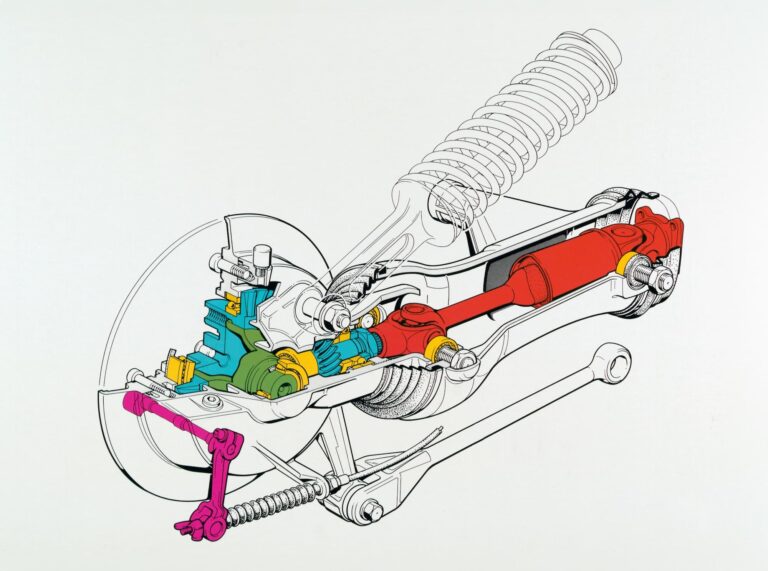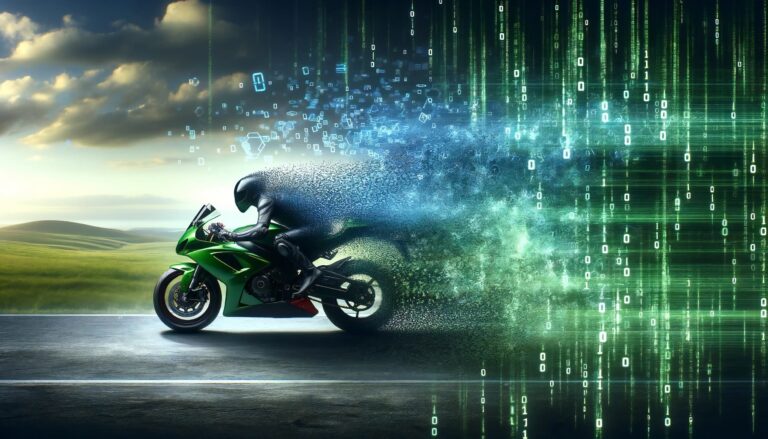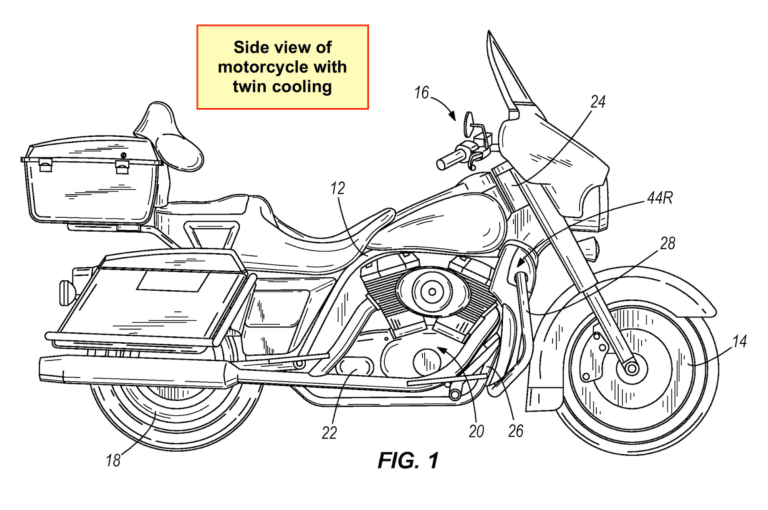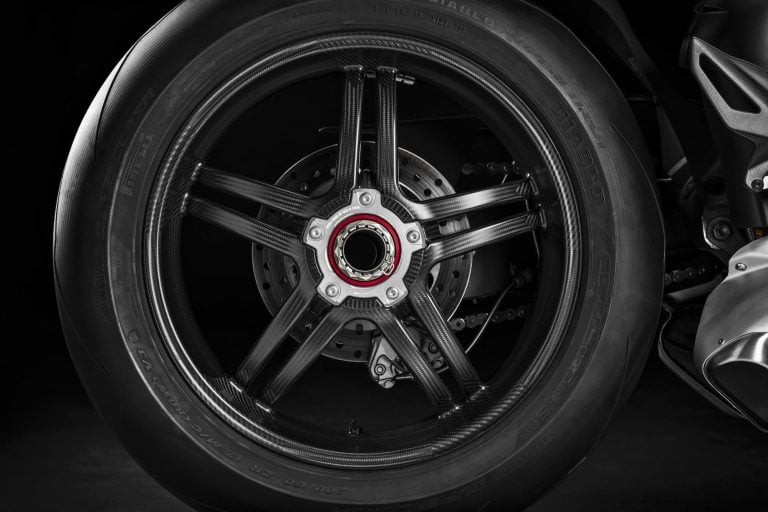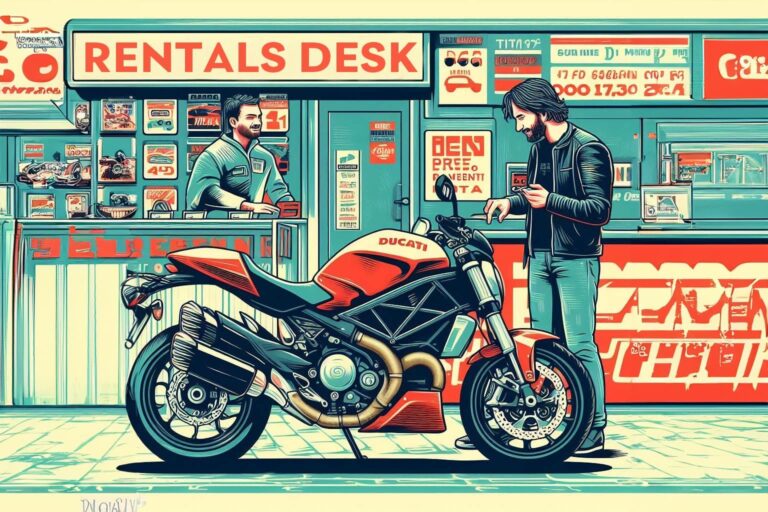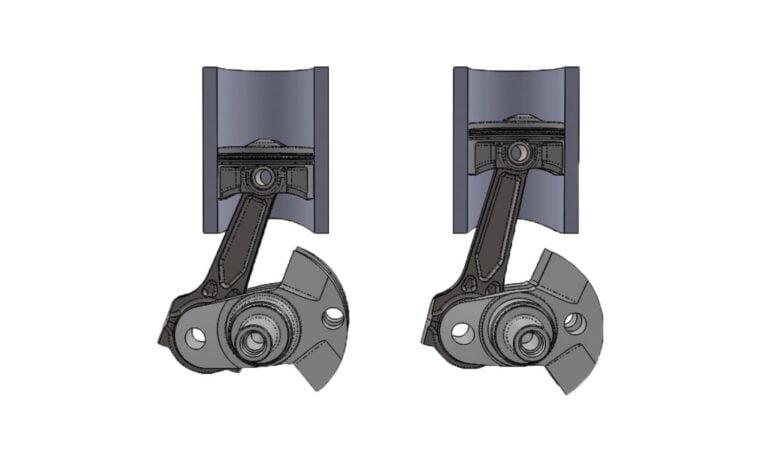As I go deeper down the motorcycling rabbit hole, I still see motorcycle technology acronyms that people seem to assume everyone knows. But they don’t! I didn’t.
Aside from brand-specific terms (looking at you Kawasaki — why does every bit of awesome tech get its own narrowly-defined acronym?), there are many acronyms that apply to all motorcycles.
Manufacturers keep adding their own as well. A few manufacturers (like Aprilia, Ducati, and Kawasaki) seem to love them in particular. I won’t put the manufacturer-specific ones here, and will keep them for another article.
And technology progresses. As active cruise control has become a thing, so have the associated acronyms!
Here’s a list of all the motorcycle acronyms I have had to learn on my journey. I hope they’re useful to you.
Are you obsessed with motorcycles?
Well, I am. That’s why I created this site — as an outlet. I love learning and sharing what others might find useful. If you like what you read here, and you’re a fraction as obsessed as I am, you might like to know when I’ve published more. (Check the latest for an idea of what you’ll see.)
Motorcycle Acronyms — Summary Table
Below is a summary table of motorcycle acronyms. More detail below.
| Acronym | Meaning |
|---|---|
| ABS | Anti-lock or Anti-skid Braking System |
| ACC | Active or Adaptive Cruise Control |
| ADV | Adventure (not really an acronym) |
| ATGATT | “All The Gear, All The Time” |
| BS (BSIV, BSVI) | Bharat Stage |
| BSD | Blind Spot Detection |
| CAS or CPS | Crankshaft Angle Sensor / Crankshaft Position Sensor |
| CC or CI | Cubic Centimetres / Cubic Inches |
| CV | Cavalli Vapore, or Caballos Vapore (metric horsepower) |
| DOT | Department of Transport |
| DCT | Dual Clutch Transmission, a kind of Honda automatic transmission |
| DRL (or DRLs) | Daytime Running Lights |
| DTC | Diagnostic Trouble Codes |
| ECU/ECM | Engine / Electronic Control Unit |
| EFI or i.e. | Electronic Fuel Injection, Iniezione Elettronica |
| FCW (system) | Forward Collision Warning |
| Ft-Lb (or lb-ft) | Foot-pound or pound-foot |
| hp, bhp, and rwhp | Horsepower, brake horsepower, rear wheel horsepower. |
| I4 | Inline Four |
| IMU | Inertia Measurement Unit |
| kW | Kilowatt, a metric measure of power |
| LCD | Liquid Crystal Display |
| LED | Light-Emitting Diode |
| Nm | Newton-metre, a metric unit of torque |
| OBD/OBDII | On-Board Diagnostics |
| ODO | Odometer (not really an acronym, you can write “Odo”) |
| OEM | Original Equipment Manufacturer, i.e. made in-house |
| OHC or DOHC | Overhead Cam or Dual Overhead Cam |
| PS | Pferdestärke, “Horse Power” in German, the metric unit. |
| PSI | Pounds per Square Inch, a measure of pressure |
| RbW | Ride-by-Wire |
| RPM | Revolutions per minute |
| RSU | Rear Suspension Unit, referring to a shock |
| SAE | Society of Automotive Engineers, a standard-setting body |
| TCS | Traction Control System |
| TDC | Top Dead Centre |
| TFT | Thin-Film-Transistor, a type of display |
| TPS | Throttle Position Sensor |
| TPMS | Tire Pressure Monitoring System |
| UJM | Universal Japanese Motorcycle. |
| USD (Forks) | Upside Down (forks) |
| WOT | Wide Open Throttle. |
ABS (Brakes)
This first one must be one of the most well-known acronyms, but it’s worth knowing exactly what it means: Anti-lock or Anti-skid Braking System.
ABS is a safety system that prevents your wheels from locking up when you run out of traction — e.g. when you brake on a slippery surface, or just brake too hard.
An ABS braking system is noticeable on any motorcycle because of (usually) two rings with many holes in it on the front and back wheels. There are sensors that detect how fast these rings are turning. The ABS system then takes these inputs to decide whether to turn on the ABS braking system.
You’ll sometiemes notice when the ABS brakes activate because you’ll feel a hard shudder in your brakes when you grab them hard.
ACC
Automatic, Active, or Adaptive Cruise Control.
Cars have had this for a little while, but in the 2020s we’re starting to see more and more high-end motorcycles with active cruise control systems. (Here’s a current and growing list)
You use an ACC system in the same way in which you use a regular cruise control button, but the systems also have radars that sense objects in front of, behind, and to the sides of motorcycles, to give inputs to the cruise control systems to slow down when they have to and to resume cruise speeds when it’s safe.
ADV
This is not an acronym, but an abbreviation that has become its own word. But the way it’s commonly written makes it look like an acronym. It’s kind of a word of its own now — people say “A-D-V” out loud.
ADV is short for ADVenture. It refers to a kind of motorcycle as well as a style of riding. People often vocalise it as “A-D-V”, spelling the letters out, even though that is no faster than the three syllables in “Adventure”.
Classic adventure bikes include the BMW GS line, or more recently the Honda Africa Twin and Yamaha Ténéré 700.
ATGATT
One of the most well-known acronyms among new riders. All The Gear, All The Time. Usually used a little pejoratively, or sarcastically. People say it out loud like a word, pronounced “at gat”.
- “Nice leathers, you going to the track?”
- “Just to buy milk… through those hills over there. ATGATT, baby!”
Some people get frustrated with “ATGATT Nazis”, who are forum dwellers or Redditors who tend to comment on any cool video with something like “Where are your boots, do you hate your feet?”
BS (as in BSIII, BSIV, BSVI)
As Indian-made motorcycles get more popular, you might come across the terms “BSIV” or “BSVI” in the press, referring to models. E.g. this is a BSVI Royal Enfield Interceptor. BS is the acronym, and the latter letters are roman numerals.
BS stands for “Bharat Stage”, an emissions regulation system implemented in India and equivalent functionally to the same Euro guidelines of the same number. So e.g. a BSVI vehicle also complies with Euro 6.
See here for more about Bharat Stage regulations.
BSD
A BSD system is a Blind Spot Detection system. (Not to be confused with the BSD the operating system software that has had the acronym for many decades.)
These are advanced rider aids that typically come with active cruise control (ACC) systems.
The aim of a BSD systems is to alert you when there’s a vehicle in your blind spot that you might not be aware of.
CAS or CPS
Crankshaft Angle Sensor or Crankshaft Position Sensor. I didn’t know what this was until one of mine went bad.
A CAS/CPS sends a signal to the computer every time the motorcycle goes past a certain point.
This tells the computer (the ECU): a) what angle the motorcycle is at, and b) what speed the engine is rotating at.
CC or CI
These acronyms refer to displacement in cubic centimetres or cubic inches.
The unit CC is quite common even in countries that often prefer imperial units for vehicle stuff, like the US and UK. Most Americans know about 600cc or literbikes, even if they’re usually unfamiliar with other metric units in everyday life. (“Quartbike” sounds odd, though it’s actually quite accurate for the Yamaha Bolt/V-Star 950/SCR950 engine!)
You see CI more often when describing Harley-Davidson motorcycles or other large cruisers, like the Suzuki M109R (or other Suzuki cruisers), which, like other Suzuki big twins, is named after its displacement in cubic inches.
CV
This acronym means Cavalli Vapore, which means “steam horses”, a kind of ghost-like animal from Italy.
I kid, this is the Italian term for horsepower. It’s metric horsepower, which is the same as PS (in Germany), and nearly the same as imperial horsepower.
The term cavalli vapore actually has its roots in the origins of the term “horsepower”. The originator of the term, James Watt, was trying to sell a steam engine to a brewer. He had to convince the brewer that his steam engine could produce more than the power of one horse. Thus, he measured the power output of the brewer’s strongest horse, and measured his steam engine’s power output in “steam horses”.
CV can also mean Caballos Vapore, which means the same thing in Spanish (steam horses) — so you’d see this in the Spanish press, too.
DOT
Department of Transport, referring to the US Department of Transport.
DOT is often mentioned because they issue various standards. A few common times you might see DOT mentioned is in
- Helmets — They have to be DOT-approved to be legal (and it’s not terribly hard to get DOT approval… so be wary of helmets that are not DOT-approved!)
- Brake/clutch fluid — You will often see motorcycles needing DOT 4 oil. This standard means that under certain pressures, the brake fluid won’t boil. DOT 3 fluid boils more easily.
- Tyres — These also have to be DOT approved to be legal.
You’ll find it in other places too, now that you know what it means…
DCT
DCT stands for Dual Clutch Transmission. It’s a Honda acronym. A DCT is a kind of automatic transmission available on bikes including the Gold Wing, the NC750X, and the Rebel 1100, among others.
Don’t confuse this with DTCs, Diagnostic Trouble Codes!
DRL (or DRLs)
All the rage in the 2020s are Daytime Running Lights, which mean “lights that make your motorcycle or car look cool when it’s on and the light is a bit dark out”.
Here are some DRLs on recent motorcycle models for you to feast your eyes on.
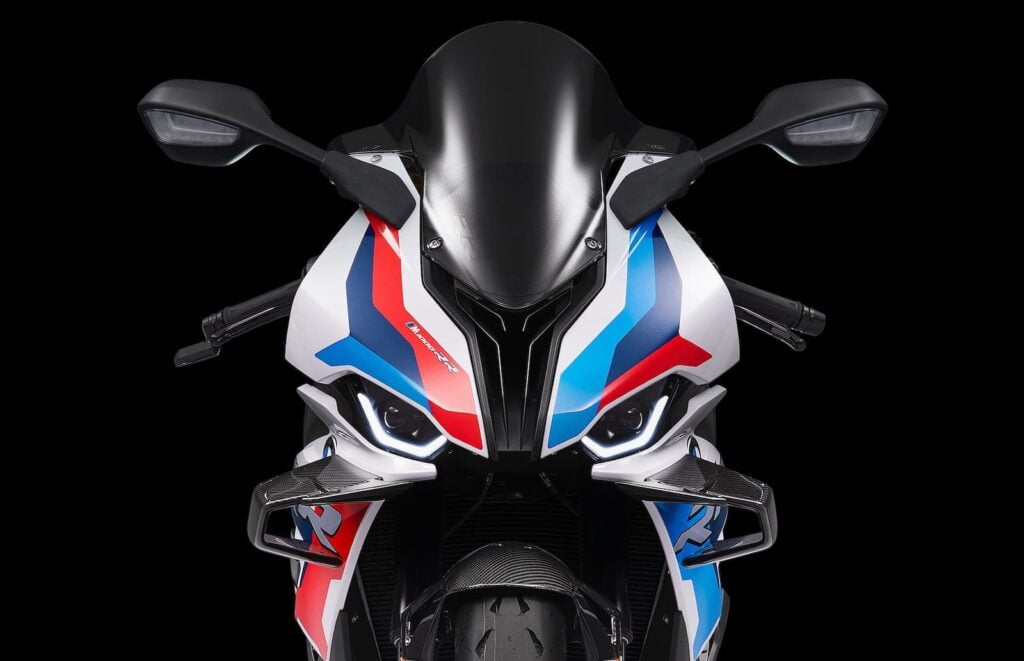
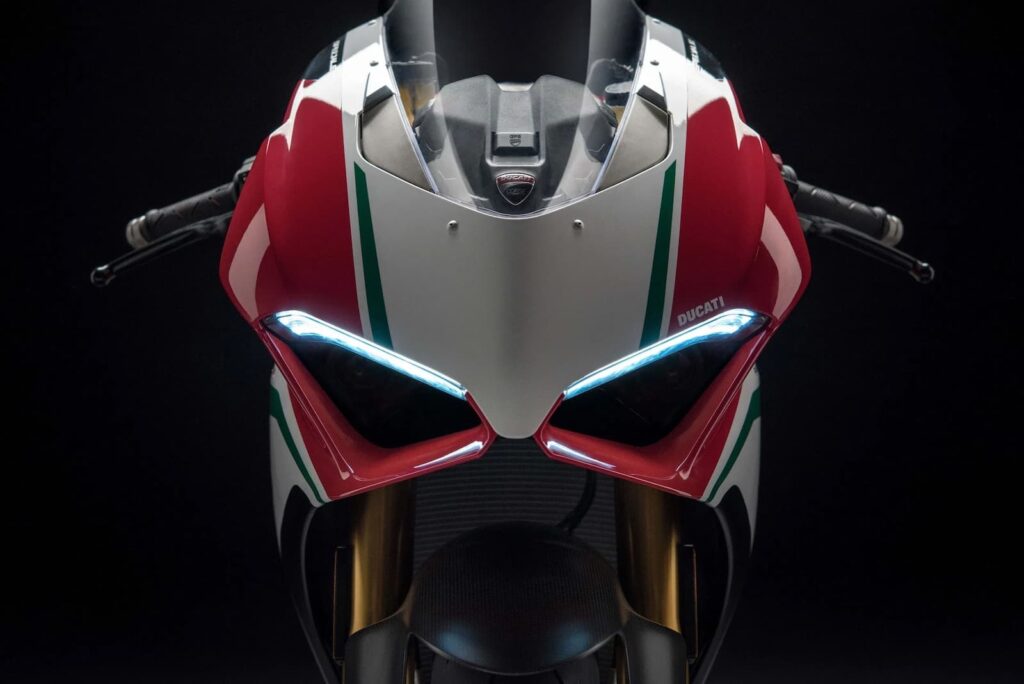
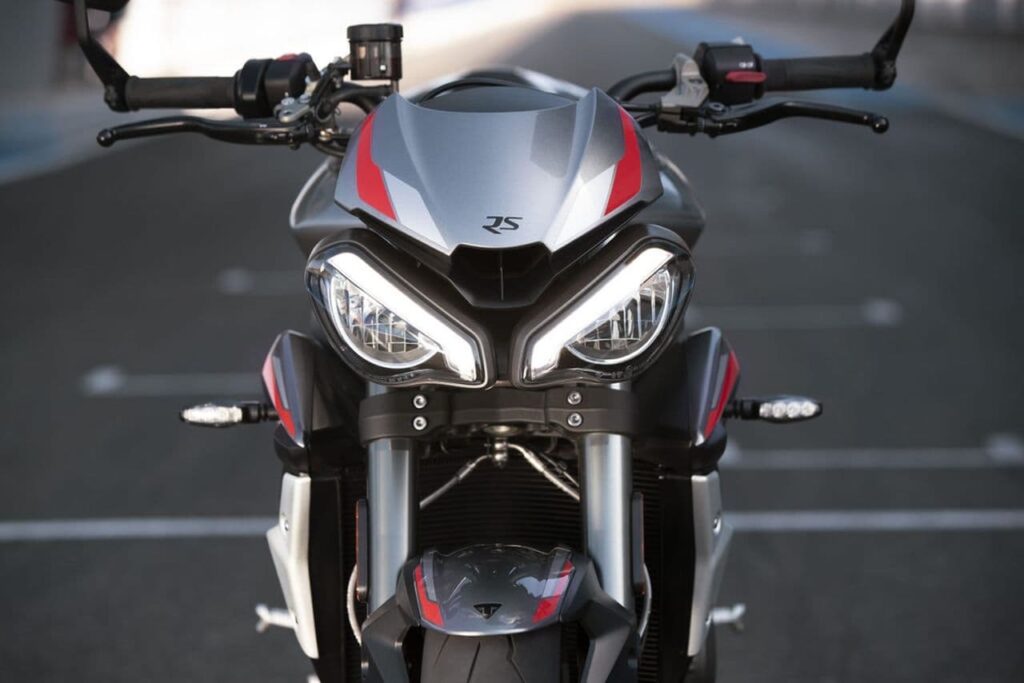
DRLs are cool, but acronyms to describe “lights” are not so cool.
DTC
Diagnostic Trouble Codes. These are codes produced by your on-board diagnostic system, your OBD (or OBDII) system.
DTCs are unique to every motorcycle.
Ducati also calls their traction control system DTC, so it’s possible that their DTC will throw some DTCs, making this one of the more confusing acronyms for Ducati motorcycles.
ECU/ECM
These two acronyms mean the “Engine Control Unit” or “Electronic Control Unit” (as these days they control a lot more than just the engine). The ECU first came around in the 90s (I believe), and became common in the 2000s and almost universal in the 2010s, as part of electronic fuel injection (EFI) systems.
The original ECUs took input from air velocity sensors and the engine speed and rotation, consulted a map of data, and sent signals to the fuel injectors and ignition coils.
These days, ECUs take even more inputs — from the throttle position sensor, air and engine temperature sensors, and sometimes even from sensors to detect the motorcycle’s acceleration/speed, lean angle, or angle in the air, and have become very complicated pieces of machinery.
EFI, or i.e.
Electronic Fuel Injection. This was the original reason we had ECUs!
In the old days (and, incongruously, sometimes even with today’s new motorcycles), all motorcycles were fed air/fuel mixture via carburettor. A carburettor lets a vacuum effect suck a little gas into the air as it blows past. It’s a very manual process.
Emissions regulations meant we couldn’t use this hacky process to put fuel into air any more, so fuel injectors were born.
We sometimes see the acronym i.e. on Italian motorcycles. It means iniezione elettronica, which means “electronic injection” in Italian.
FCW (system)
An FCW system is a Forward Collision Warning system.
These are part of the suite of rider aids that come with radars for active cruise control (see ACC).
An FCW system alerts you when there’s something either stationary or moving much more slowly than you that’s in front of you. It’s still up to you to brake or swerve.
Ft-Lb (or lb-ft)
These two acronyms describe twisting force, torque, and mean “foot-pound” or “pound-foot”. They’re interchangeable.
A ft-lb or lb-ft is the imperial measurement of torque, equivalent to Nm in metric units. Torque is rotational pull. One foot-pound is equivalent to a pound of force with leverage of one foot.
The more ft-lb of torque, the more your motorcycle will pull at a given RPM.
People get into wars with each other about whether it’s ft-lb, lb-ft, or lbf-ft (as it’s a pound of force, not of weight). But this is an issue where it’s always obvious what the intention is, so I don’t get hung up on linguistic prescriptivism.
hp, bhp, and rwhp
Horsepower! The imperial unit of measurement. One horsepower is equal to the power of one horse, I suppose.
Horsepower is sometimes written bhp, which is short for “brake horsepower”. It’s the same thing, but refers to the way that horsepower is measured on a dyno, using a roller that measures the braking force once the engine id running at a desired rate.
The acronym rwhp means “rear wheel horsepower”, referring to power measured at the wheel, rather than the power at the crank (which is measured best in a lab, and is often a reported figure that comes from manufacturers).
One imperial horsepower is defined as being 550 foot-pounds per second.
See my guide to the math of power and torque for more about these units.
Note that hp can sometimes refer to metric horsepower, which has a slightly different definition… it’s about 1% off.
I4
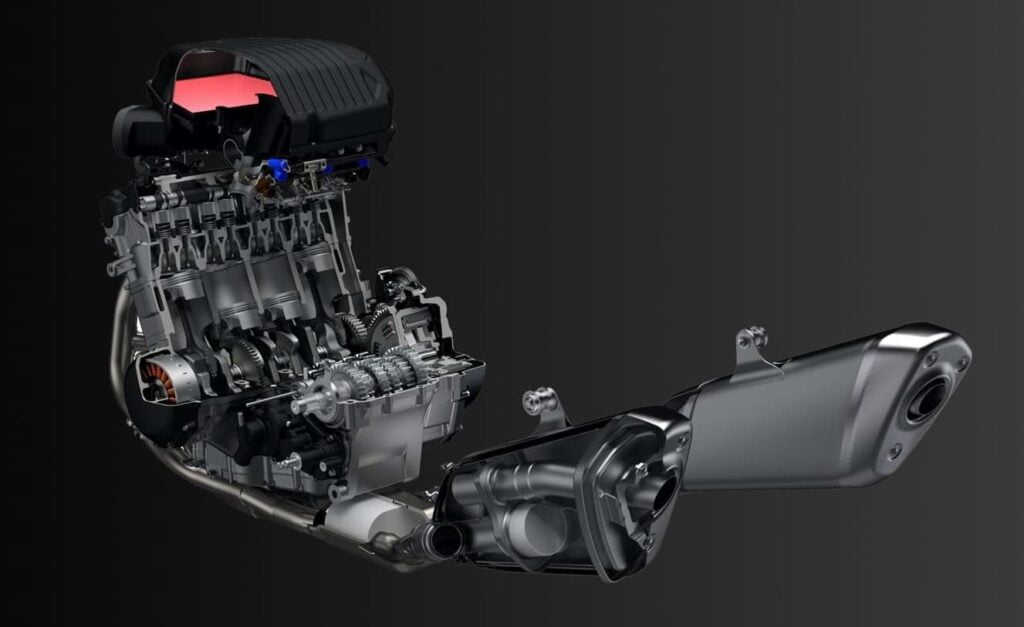
Some acronyms are just short-hand ways of describing an engine. The term “I4” means “Inline four”, referring to the number and configuration of cylinders in an engine.
Other common configurations are V-twin, boxer, a triple, flat six, and a parallel twin, but none of these resulted in an acronym. (E.g. unlike V8, nobody says V2 unless referring to the Panigale V2).
IMU
Inertia Measurement Unit.
An IMU measures the angle of the motorcycle across multiple axis, to detect when it’s leaning to the left and right (when you’re banking), forwards and backwards (when you’re accelerating or braking), or turning.
The IMU then takes this input and gives it to both the ABS controller as well as to the motorcycle’s computer for the purpose of controlling traction.
kW
This acronym is Kilowatt (written kW when abbreviated), a metric measure of power.
To convert to kW, you multiply horsepower roughly by 0.75 (see my quick hacks to convert between metric and imperial units page).
Note that you can use kW to describe the power input or output of anything — an engine, a dynamo, lights, an electrical system, etc. So
LCD
Liquid Crystal Display. These have been around for decades, but we started seeing them replacing the dials on motorcycles in the late nineties and early 2000s. It’s technically not write to say “LCD display” but people say that colloquially.
Eventually, many motorcycles went to an entire backlit LCD, before they started to be replaced by TFT displays, which mercifully don’t have the D for “display” in them.
LED
Light-Emitting Diode.
Originally a very fancy technology that used a lot of power to produce a little bit of light in a weird colour, LEDs have become incredibly efficient in the past few decades, and can produce a wide spectrum of light.
Modern LEDs use less power, are often brighter (while being cooler), and are more reliable than old-school filament bulbs, which is why many people upgrade their lights to LED lights, and why many new bikes brag about being fully LED-equipped.
Nm
Newton-metres, a metric measurement of torque, equivalent to ft-lb.
A Newton-metre of torque is equivalent to a Newton of force with leverage of a metre of length.
A Newton of force is equivalent to the amount necessary to accelerate a kilogram of mass at a rate of one meter per second squared.
If that sounds too esoteric, you can convert the Nm figure like this if an engine makes 100 lb-ft of torque, it’s making about 135 Nm; i.e multiply it by about 4/3. (This is one of my simple metric/imperial conversion hacks.)
OBD/OBDII
On-Board Diagnostics.
An OBD system is an electronic system that lets a motor vehicle self-diagnose.
When a vehicle “throws codes” (DTCs, or Diagnostic Trouble Codes) it is a result of the OBD system diagnosing itself as encountering some problem.
This is mostly an car standard, but many motorcycles (like my old Triumph Scrambler EFI) also use the OBD system, which means you can use an automotive scan tool to check the error codes (DTCs) your motorcycle is throwing.
ODO
Not actually an acronym even though people write it as if it is. Means “Odometer”, which measures your odour.
Jokes aside, the etymology of “odometer” is from the Ancient Greek word οδόμετρο, combining οδός (odós), “path”, and μέτρο (métro), “measure”, which combines to “Path measure”.
OEM
Original Equipment Manufacturer. It’s not a brand; it refers to the brand of the bike that might make a part or replaceable component like brakes.
If you ask someone “What brand of replacement part did you buy?” and they say “OEM”, they mean “I’m just using a part that the manufacturer of my bike makes”.
OHC or DOHC
OverHead Cam, or Dual OverHead Cam.
Motorcycles have had overhead camshafts for a long time — since the 90s. Dual overhead camshafts (also known as “twin cam” engines”) became much more common since around the 2010s. But there are still engines that don’t use them, like large V-twins that use pushrod style engines, with a camshaft underneath the cylinder head, pushing overhead valves.
An OHC or SOHC (“Single”) engine has one camshaft per cylinder head, controlling both the intake and exhaust valves. By contrast, DOHC engines have a camshaft for the intake valves and a camshaft for the exhaust valves.
OHV
The counterpart to OHC, OHV means Overhead Valve.
Many V-twin engines, notably those from Harley-Davidson and Moto Guzzi, are OHV in design.T
PS
Not to be confused with PSI (the unit of pressure), PS is a German acronym that stands for Pferdestärke… which translates to “horsepower”! A Pferd is a horse, and Stärke is one of the many words German has for “power”.
The PS standard is also known as “metric horsepower”. It’s equivalent to CV (Cavalli Vapore, see above).
One PS is defined as 75 kilograms of force (kg.f) x m/s. It comes out as being about 0.7355 W. So even though PS has the same root as hp (horsepower), it’s not quite the same — 100 horsepower is about 101 PS.
PSI
Pounds per Square Inch, a unit of pressure. Used to describe tyre pressure. Most motorcycle tyres run pressures between 28 and 42 psi — most often, somewhere in between.
This is an imperial unit. In Europe, people often use the metric unit of bar (1 bar = 100 kPa), and in Asia, the metric unit of kPa is used.
RbW
Ride-by-Wire.
Most motorcycles (even today) use a throttle cable which directly goes down to the throttle bodies, or sometimes the carburettors. But ride-by-wire is becoming more prevalent.
A Ride-by-wire system means that the throttle just actuates a sensor that sends an electronic system to the ECU who figures out what to do with that signal.
A RbW system sometimes can feel unnatural if it’s not well-made, but I’ve never personally seen that felt too light.
RPM
Revolutions per minute. This acronym is very common and thus not always capitalised, and is often written “rpm”. Used to describe engine speed. For example, an engine turning at 3,000 rpm makes a full rotation 3000 times a minute, or 50 times a second!
Note that in a single-cylinder four-stroke engine, the piston fires once every two revolutions. So a single-cylinder engine turning at 3000 RPM would have its single cylinder fire 25 times a second. But a four-cylinder engine running at 3000 rpm would have 100 ignitions a second — which is why they scream at high rpms, compared to twins.
RSU
An RSU is a “Rear Suspension Unit”, otherwise known as a “shock” or as “shocks”. It can apply to either a single shock or a pair of shocks.
Not every manufacturer uses the terminology RSUs, but I’ve seen it on Triumph and Royal Enfield motorcycles at least. It doesn’t help that so many Triumph motorcycles are named “RS”… so you want RSUs for an RS… c’mon.
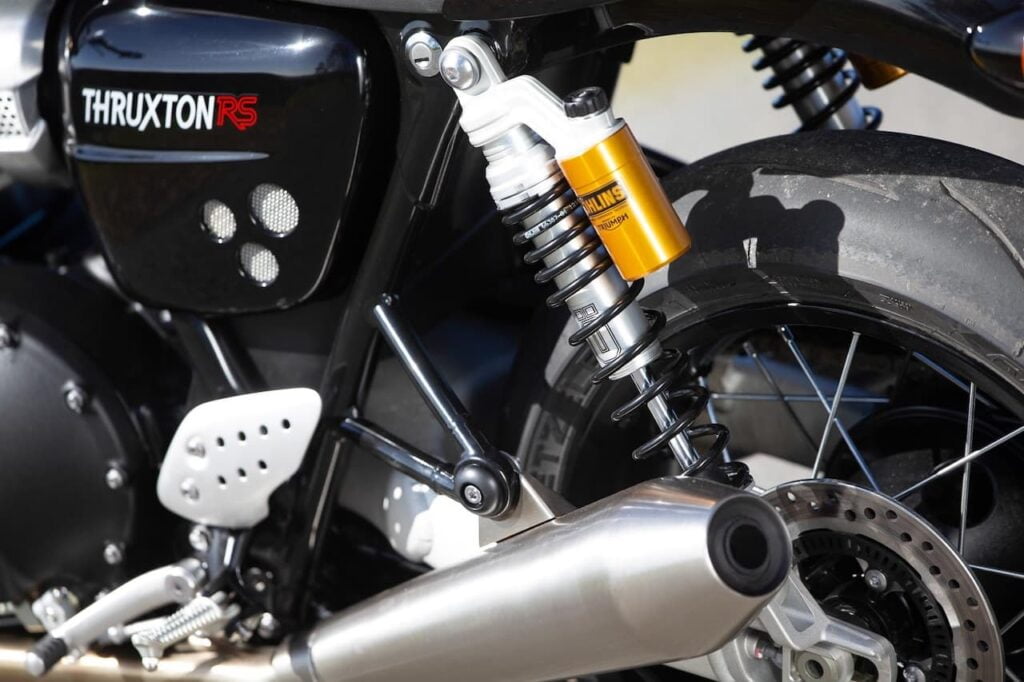
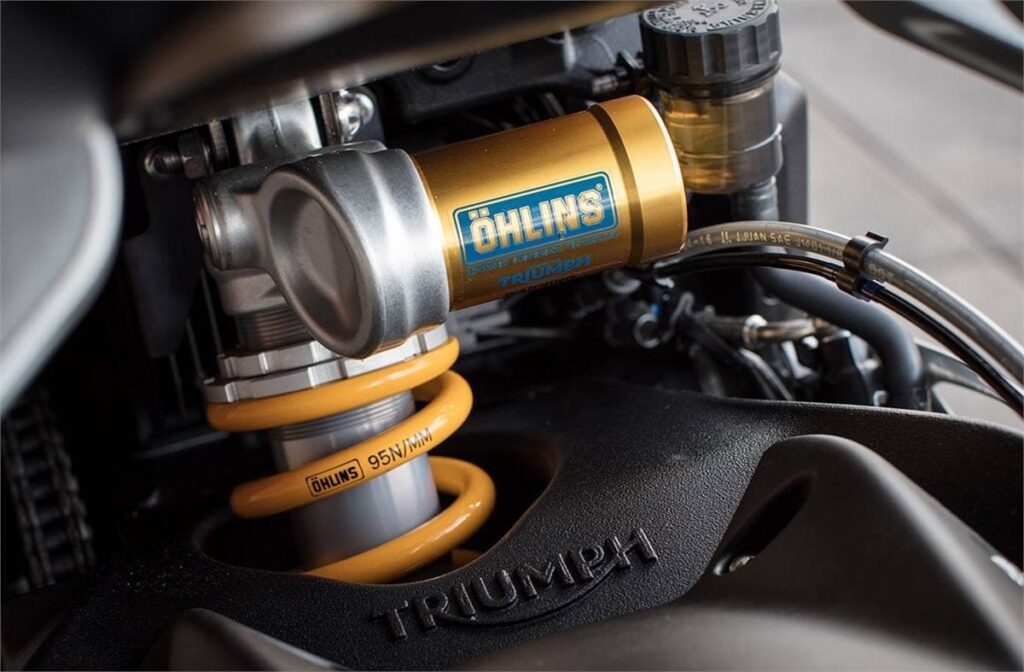
SAE
One of two acronyms referring to a standards body, this one the Society of Automotive Engineers.
Like DOT, SAE gives out standards which are used in various things like oils.
TCS
A Traction Control System. These limit power in some way (e.g. stopping ignition) when the motorcycle’s computer figures out that you’ve broken traction on one wheel. One way it might do this is using the ABS sensor rings, figuring out that one wheel is spinning faster than the other.
You’ll notice when TCS is activated because just as a wheel starts spinning (e.g. when you try to launch hard on a slippery surface, like on dirt), your engine will cut out slightly.
TDC
Top Dead Centre. Not to be confused with DTC.
Used when discussing how to check valve timing — you have to use some method (e.g. rotating the rear wheel while in gear, or using a crankshaft rotating tool) to get the pistons to the “Top Dead Centre” position.
TFT
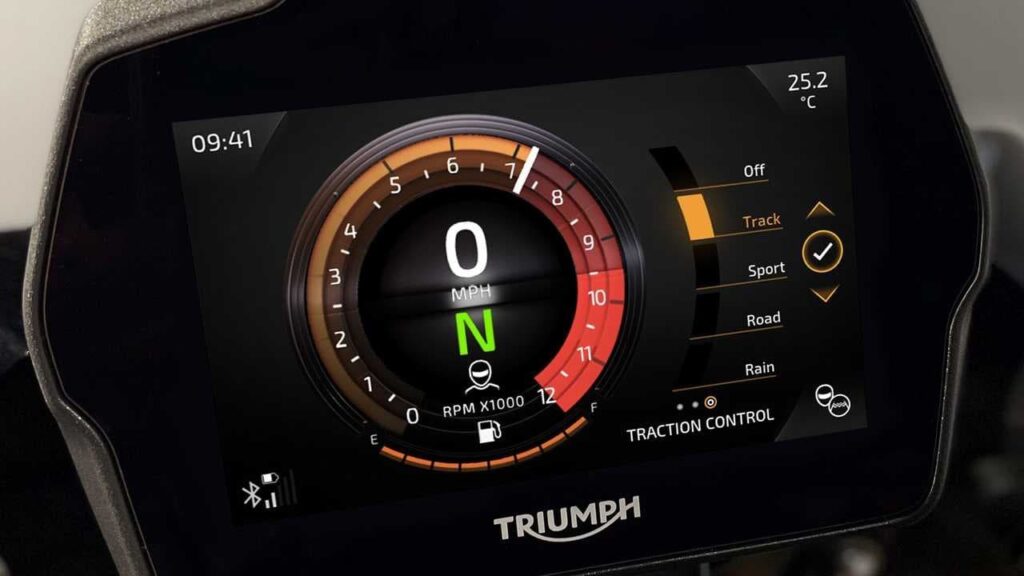
Thin-Film-Transistor. Actually a TFT display is a kind of LCD, but people usually refer to them simply as being a TFT display.
These days if you see marketing blurbs that claim a display is TFT, it usually means that it’s a colour display.
TPS
Throttle Position Sensor. This is a sensor that measures how far the throttle is open.
The sensor doesn’t have to be at the throttle; it was originally at the throttle butterfly, so it’s not exclusive to RbW systems.
On modern fuel-injected motorcycles, the ECU will take input from the TPS to know how hard the rider is twisting the throttle. This is one of the inputs into determining how much fuel to give the motor as well as when to ignite it.
The TPS actually was even used on carburettor motorcycles with digital ignition. The position of the TPS didn’t affect fuelling on those, but it did inform ignition.
TPMS
Tire Pressure Monitoring System. Fancy!
These are sometimes aftermarket units, or sometimes come standard or as an option on motorcycles. They display your tyre pressures on the dash, and can send alarms when pressure goes low.
UJM
Universal Japanese Motorcycle. Somewhat pejorative originally, but these days they recall an age of great bikes.
In the 1980s, people started noticing that the big four Japanese motorcycle manufacturers all were producing large capacity standard motorcycles with inline-four transversely-mounted engines. They all seemed the same in many ways, though they had distinguishing characteristics (air vs liquid-cooled, chain vs shaft drive, etc.)
My first motorcycle was a UJM before I even knew what they were — my 1981 Honda CB900 Bol d’Or. (Here are my thoughts on this bike, and my regret about selling it.)
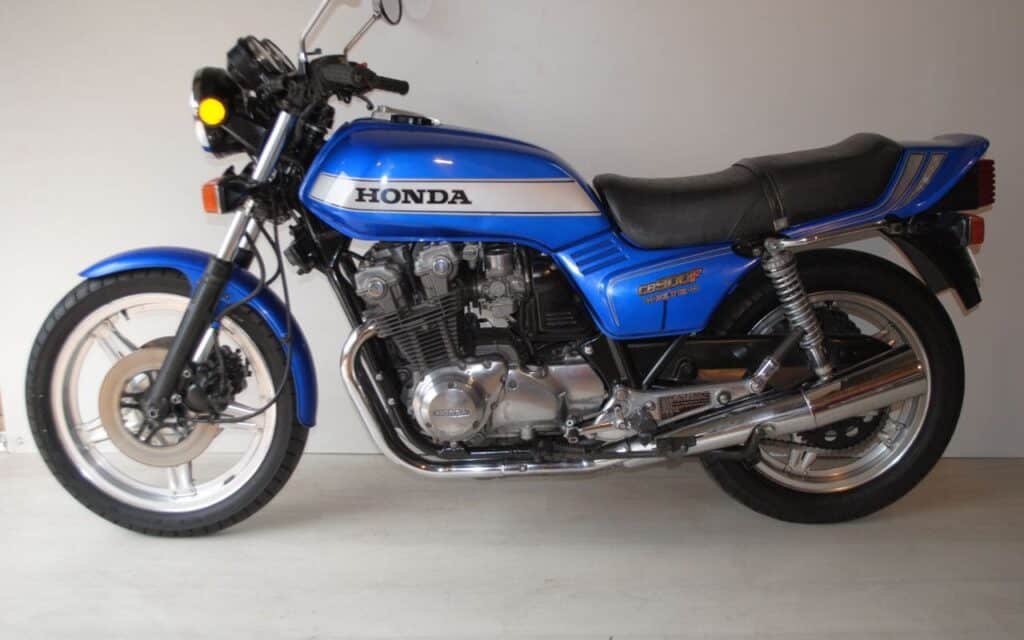
USD (Forks)
No these are not US dollar forks (which is what I admittedly first thought, long ago)! In the past, forks were forks, until in the nineties some sportbikes started to be released with “upside-down” forks.
“Upside-Down” forks, or “USD” or “inverted” forks, have the fork stanchion (usually the shiny bit) at the bottom, and the fork tube at the top. The goal of USD forks is to reduce un-sprung mass, increasing traction. See my full motorcycle fork explainer here.
WOT
Wide Open Throttle. When you’re giving it the beans. I have never heard this said out loud, only written down.

